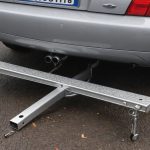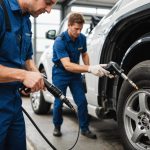Importance of Vehicle Frame Integrity Assessment
Evaluating the vehicle frame integrity is crucial after an accident, as it directly affects safety and performance. The vehicle frame forms the backbone of any car, providing support to various components and ensuring stable handling. Accident assessment includes checking this framework because any compromise in its integrity can have dire consequences.
Frame damage can manifest in various ways, such as misalignment, weakened structural points, or cracked sections. Such damage significantly impacts the vehicle’s ability to absorb impacts, affecting safety during future collisions. Beyond safety, it can lead to poor vehicle performance, including issues with alignment and handling, making timely evaluation imperative.
In parallel : Ultimate guide to windshield wiper replacement: achieve perfect clarity during stormy weather
Safety evaluation is necessary to ensure that vehicles remain safe to drive. This involves not only identifying damage but also understanding its implications on the frame’s overall strength and functionality. Accurate assessments allow for informed decisions, ensuring repairs restore the vehicle to its original safety standards. After an accident, prioritizing frame integrity assessment helps maintain the vehicle’s durability and protect passengers effectively. It is critical that such evaluations are carried out by professionals who can identify even subtle indicators of damage, ensuring comprehensive safety checks and necessary repairs.
Essential Methods for Evaluating Frame Integrity
Proper assessment methods are fundamental to determine any damage to the vehicle frame, safeguarding safety and functionality. These methods involve a blend of visual inspection, precise measurements, and advanced diagnostic technologies.
In parallel : Critical safety tips for aftermarket suspension kit installations: sidestep common mistakes
Visual Inspection Techniques
Visual inspection is the first step in evaluation methods. Key inspection techniques include checking for misalignment and irregular gaps in the body panels, which can indicate underlying structural issues. Examining weld points for cracks or rust is essential, as these are common frame damage indicators.
Measuring Tools and Equipment
To supplement visual techniques, precise measurement tools play an integral role. Devices like measuring tapes, angle finders, and plumb lines help detect deviations in the frame’s geometry. These tools offer an objective record, vital for a comprehensive structural evaluation.
Diagnostic Technology
Advancements in diagnostic technology have introduced sophisticated solutions such as laser-guided measuring systems. These provide 3D scans of the vehicle, highlighting any deviations from the manufacturer’s specifications. Such technology facilitates a detailed examination of structural integrity and can reveal collision effects not visible to the naked eye.
Utilising a combination of these inspection techniques and technologies ensures a robust approach to maintaining vehicle safety and performance after an accident.
Step-by-Step Evaluation Process
When engaging in a thorough evaluation process of a vehicle’s frame, a structured approach is key. It begins with an inspection checklist, detailing specific areas to examine. Start by accessing vehicle lift points for stability, as well as examining welds for cracks or excessive rust. These conditions often signal potential issues.
Progress to reviewing body panels for misalignment and unusual gaps, serving as clear frame damage indicators. Moving methodically through the checklist ensures nothing is overlooked. Important details such as structural anomalies may affect not only immediate safety but also future performance.
Safety protocols are essential throughout this process, particularly when working with vehicles post-accident. Always secure the vehicle safely before inspection and wear protective gear to prevent injuries. Even slight collision effects can result in significant safety hazards if not properly addressed.
This diligent, checklist-driven approach, adhering closely to safety measures, enables a comprehensive evaluation. By following standardized procedures, one ensures consistent assessments and facilitates effective repairs to restore the vehicle’s frame integrity and reliability. Each step in this process is critical to ensuring the vehicle’s overall structural health and operational safety.
Signs of Frame Damage to Look For
When it comes to identifying frame damage indicators, understanding the physical signs is essential for any vehicle owner. One of the primary indicators is frame distortion, which can present as visible bends or misalignment in the vehicle’s structure. This may affect not only the car’s appearance but also its overall driving dynamics.
Another important element is the impact of damage on the vehicle’s suspension and alignment systems. Misalignment can lead to uneven tyre wear, difficulty in steering, and an overall unsafe driving experience. These structural anomalies affect the vehicle’s ability to handle properly, especially during sudden maneuvers or adverse conditions.
Previous collision effects can compromise frame integrity, leading to hidden damages that may not be immediately visible. It’s critical to inspect areas that absorb impact, like crumple zones and other reinforced sections. Identifying these issues sooner rather than later can prevent further deterioration, ensuring that necessary repairs are conducted before safety is entirely jeopardised.
For effective and safe driving, routinely checking for any signs of frame misalignment or damage, and addressing them promptly, is crucial. Always prioritise safety by remaining vigilant against these common indicators of structural integrity failure.
Implications of Frame Damage on Vehicle Safety
Understanding the safety implications of a compromised vehicle frame is paramount for all vehicle owners. Structural integrity directly influences how a vehicle performs, particularly during collisions or in challenging driving conditions. A sturdy frame absorbs and dissipates impact forces, safeguarding passengers. In contrast, frame damage can lead to unsafe driving dynamics and increased injury risk in future accidents.
Driving with a weakened frame exposes drivers to significant safety risks. The vehicle may not handle unexpected maneuvers properly, putting it at a higher risk for rollover incidents or failure to protect occupants in a crash. Misaligned frames can also result in uneven tyre wear, impairing control and stability.
Beyond immediate safety concerns, legal and insurance considerations can complicate matters. Vehicles with known frame damage may not meet roadworthiness standards, potentially leading to fines or invalidated insurance claims. Moreover, lingering structural damage can negatively impact resale value, as potential buyers often avoid purchasing vehicles with an accident history affecting structural integrity.
Addressing frame damage promptly through professional evaluations and necessary repairs not only enhances safety but also ensures compliance with legal and insurance requirements. Regular assessments help maintain the integrity of the vehicle, fostering confidence and peace of mind for drivers.
Expert Tips for Accurate Assessment
Understanding how to conduct expert assessments is crucial for maintaining vehicle safety following an accident. Engaging with seasoned professionals ensures that the evaluation tips used are both comprehensive and precise, assessing the intricate facets of frame integrity.
Consulting with Professionals
When contemplating an evaluation process, it is essential to involve qualified professionals. These experts utilize advanced inspection techniques to detect even subtle damage that might otherwise go unnoticed. Hiring a trusted mechanic or collision specialist can help identify underlying issues, allowing for timely and efficient repairs.
Importance of Documentation
Proper documentation is a key aspect of any safety evaluation. It ensures that a detailed record of assessments and repairs is maintained, proving invaluable should there be any future claims or transactions. Such records provide a transparent account of the vehicle’s history, maintaining its structural integrity.
Understanding Repair Implications
Evaluating frame damage indicators and understanding their implications is critical. A comprehensive assessment impacts not only the immediate safety of the vehicle but also its resale value. Moreover, accurate evaluations influence insurance claims by ensuring compliance with legal safety standards. Regular checks uphold the vehicle’s durability and accident assessment validity, fostering peace of mind for the owner.
Case Studies and Real-World Examples
Exploring real-world case studies provides valuable insights into effective vehicle frame integrity assessments. One notable example involves a mid-sized sedan that underwent an accident assessment following a moderate rear-end collision. Initial visual inspection techniques detected minor misalignments on the body panels. However, advanced assessment methods, including laser-guided diagnostics, revealed significant unseen damage to the suspension system. This thorough evaluation was crucial in restoring the vehicle back to structural integrity, ensuring passenger safety.
Case studies emphasize the importance of integrating diverse inspection techniques. In a different scenario, an SUV experienced severe side impact. Visual inspection showed obvious collision effects, like dented panels and misaligned doors. The vehicle was subjected to structural evaluation, employing both conventional and cutting-edge tools. The rigorous assessment, alongside expert guidance, revealed compromised crumple zones, leading to a comprehensive repair strategy.
These real-world assessments illustrate not only the necessity of timely and accurate assessment methods, but also the leveraging of professional expertise. By learning from these examples, vehicle owners comprehend the significance of meticulous accident assessment in maintaining frame integrity, safeguarding safety evaluation, and achieving optimal performance restoration post-collision.






